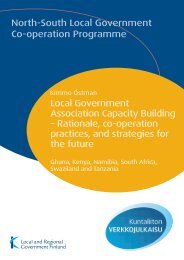E-READINESS QUESTIONNAIRE FOR NORTH ... - Kunnat.net
E-READINESS QUESTIONNAIRE FOR NORTH ... - Kunnat.net
E-READINESS QUESTIONNAIRE FOR NORTH ... - Kunnat.net
You also want an ePaper? Increase the reach of your titles
YUMPU automatically turns print PDFs into web optimized ePapers that Google loves.
5 Kenya<br />
5.1 Background and Government<br />
44<br />
Kenya is a country in Eastern Africa. It is bordered by Ethiopia to the north, Somalia<br />
to the east, Tanzania to the south, Uganda to the west, and Sudan to the northwest,<br />
with the Indian Ocean running along the southeast border 59 .<br />
Founding president and liberation struggle icon Jomo Kenyatta led Kenya from independence<br />
in 1963 until his death in 1978, when President Daniel Toroitich Arap Moi<br />
took power in a constitutional succession. The country was a de facto one-party state<br />
from 1969 until 1982 when the ruling Kenya African National Union (KANU) made<br />
itself the sole legal party in Kenya. Moi acceded to internal and external pressure for<br />
political liberalization in late 1991. The ethnically fractured opposition failed to dislodge<br />
KANU from power in elections in 1992 and 1997, which were marred by violence<br />
and fraud, but were viewed as having generally refl ected the will of the Kenyan<br />
people. President Moi stepped down in December 2002 following fair and peaceful<br />
elections. Mwai Kibaki running as the candidate of the multiethnic, united opposition<br />
group, the National Rainbow Coalition (NARC), defeated KANU candidate Uhuru<br />
Kenyatta and assumed the presidency following a campaign centered on an anticorruption<br />
platform. Kibaki’s NARC coalition splintered in 2005 over the constitutional<br />
review process. Government defectors joined with KANU to form a new opposition<br />
coalition, the Orange Democratic Movement, which defeated the government’s draft<br />
constitution in a popular referendum in November 2005. Kibaki’s reelection in December<br />
2007 brought charges of vote rigging from ODM candidate Raila Odinga and<br />
unleashed two months of violence in which as many as 1,500 people died. UN-sponsored<br />
talks in late February produced a power sharing accord bringing Odinga into the<br />
government in the restored position of prime minister.<br />
Kenya is divided into seven provinces: Coast, Northeastern, Eastern, Central, Rift<br />
Valley, Nyanza, and Western. These are subdivided into 63 districts, each headed by a<br />
presidentially appointed commissioner; provincial administration is closely supervised<br />
by the central government. There are two types of upper local authorities (municipalities<br />
and county councils) and four types of lower authorities (urban councils, township<br />
authorities, area councils, and local councils). The Nairobi area is separate and has special<br />
status. The Nairobi area, administered by a city council, is the direct responsibility<br />
of the central government. Many of the councils raise their own revenues by taxes,<br />
construct and maintain roads, carry out public health schemes, construct and improve<br />
housing, support education, and provide agricultural and social welfare services 60 .<br />
5.2 Geography and Demography<br />
Kenya has a total land area of 580,367 sq km and a population of 39,002,772. It has a<br />
youthful population comprising the following:<br />
� 0-14 years: 42.3% (male 8,300,393/female 8,181,898)<br />
� 15-64 years: 55.1% (male 10,784,119/female 10,702,999)<br />
� 65 years and over: 2.6% (male 470,218/female 563,145) (2010 est.)<br />
59 http://www.international.ucla.edu/africa/countries/article.asp?parentid=96749<br />
60 http://www.nationsencyclopedia.com/Africa/Kenya-LOCAL-GOVERNMENT.html




